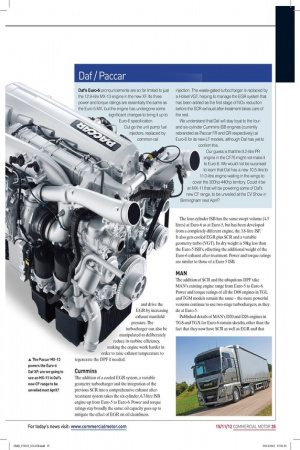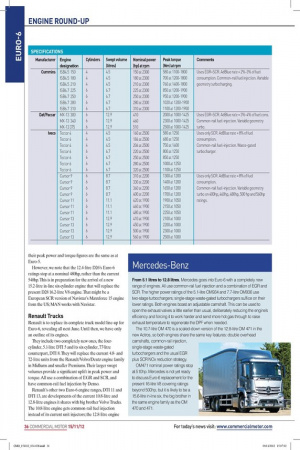Six appeal
Page 25

Page 26

Page 27

Page 28

Page 29

If you've noticed an error in this article please click here to report it so we can fix it.
If you’re planning to defer your first Euro-6 engines for as long as possible, it’s useful to know what you are missing. CM rounds up the runners and riders in the Euro-6 engine stakes
Words: David Wilcox All Euro-6 engines will have exhaust after-treatment incorporating a diesel oxidation catalyst (DOC) and diesel particulate filter (DPF), followed by an SCR NOx reduction system. This means no truck operator will be able to side-step AdBlue or the occasional need to remove ash (derived from engine oil) accumulated in the DPF.
Apart from these two common features, there are some very real differences in the manufacturers’ Euro-6 strategies. While most Euro-6 engines will cut NOx using a combination of in-engine EGR and SCR exhaust after-treatment, the relative proportions of each will vary from one manufacturer to another. This means the AdBlue consumption rate will also vary – the quantity of AdBlue needed is directly proportional to the amount of NOx the SCR system has to deal with. Less EGR means more SCR and thus a higher AdBlue consumption rate.
Euro-6 engines using more EGR than most are claimed to sip AdBlue at a rate equivalent to about 2.5% of their fuel consumption; the rate for SCR-only engines such as Iveco’s is expected to be 8%.
Assuming an AdBlue price of 30p/litre and a truck averaging 8.5 mpg and covering 140,000km a year, the annual AdBlue cost at a rate of 2.5% is £350; at 8% it is £1,120. Wherever possible, our table quotes Euro-6 AdBlue consumption rates claimed by the manufacturers.
Another key difference is turbocharging strategy. As a and drive the EGR by increasing exhaust manifold pressure. The turbocharger can also be manipulated to deliberately reduce its turbine efficiency, making the engine work harder in order to raise exhaust temperature to regenerate the DPF if needed.
Cummins
The addition of a cooled EGR system, a variable geometry turbocharger and the integration of the previous SCR into a comprehensive exhaust aftertreatment system takes the six-cylinder, 6.7-litre ISB engine up from Euro-5 to Euro-6. Power and torque ratings stay broadly the same: oil capacity goes up to mitigate the effect of EGR on oil cleanliness. The four-cylinder ISB has the same swept volume (4.5 litres) at Euro-6 as at Euro-5, but has been developed from a completely different engine, the 3.8-litre ISF. It also gets cooled EGR plus SCR and a variable geometry turbo (VGT). Its dry weight is 50kg less than the Euro-5 ISB’s, offsetting the additional weight of the Euro-6 exhaust after-treatment. Power and torque ratings are similar to those of a Euro-5 ISB.
MAN
The addition of SCR and the ubiquitous DPF take MAN’s existing engine range from Euro-5 to Euro-6. Power and torque ratings of all the D08 engines in TGL and TGM models remain the same – the more powerful versions continue to use two-stage turbochargers, as they do at Euro-5.
Published details of MAN’s D20 and D26 engines in TGS and TGX for Euro-6 remain sketchy, other than the fact that they now have SCR as well as EGR and that their peak power and torque figures are the same as at Euro-5.
However, we note that the 12.4-litre D26’s Euro-6 ratings stop at a nominal 480hp, rather than the current 540hp. This is in preparation for the arrival of a new 15.2-litre in-line six-cylinder engine that will replace the present D28 16.2-litre V8 engine. That might be a European SCR version of Navistar’s Maxxforce 15 engine from the US; MAN works with Navistar.
Renault Trucks
Renault is to replace its complete truck model line-up for Euro-6, revealing all next June. Until then, we have only an outline of its engines.
They include two completely new ones, the fourcylinder, 5.1-litre DTI 5 and its six-cylinder, 7.7-litre counterpart, DTI 8. They will replace the current 4.8and 7.2-litre units from the Renault/Volvo/Deutz engine family in Midlums and smaller Premiums. Their larger swept volumes provide a significant uplift in peak power and torque. All use a combination of EGR and SCR, and have common-rail fuel injection by Denso.
Renault’s other two Euro-6 engine ranges, DTI 11 and DTI 13, are developments of the current 10.8-litre and 12.8-litre engines it shares with big brother Volvo Trucks. The 10.8-litre engine gets common-rail fuel injection instead of its current unit injectors; the 12.8-litre engine stays with unit injectors. Both will use EGR and SCR; see the Volvo section for some clues about AdBlue consumption. Their power and torque ratings are much the same as at Euro-5.
Scania
Scania has a unique Euro-6 strategy, offering both SCR-only engines (the 320hp and 360hp variants of its five-cylinder, 9.3-litre DC09) and EGR plus SCR for the other ratings of the DC09 and the 440hp and 480hp ratings of the 12.7-litre DC13.
But that still leaves some missing Euro-6 data, relating to the 370hp and 410hp DC13 engines, and all versions of the DC16 V8. Apart from their peak power ratings, Scania has released no details of these yet.
All the Euro-6 engines we know about so far use the Scania/Cummins XPI common-rail fuel injection system and all have variable geometry turbochargers. Scania says AdBlue consumption of its EGR-plus-SCR engines is going to be 3%-4% of their fuel consumption.
It is logical to assume that the SCR-only engines will use AdBlue at a rate similar to that quoted by Iveco for its SCR-only engines, namely 8%.
Volvo Trucks
Volvo has so far released details of just one Euro-6 engine (the 460hp D13K in the new FH) but it is not hard to figure out more from either its bus division – which has published some Euro-6 engine data – or sister company Renault Trucks.
Volvo’s Euro-6 trucks will definitely use three core engine ranges: the 7.7-litre D8K, the 10.8-litre D11K and the 12.8-litre D13K.
See the Renault Trucks section for more details of these engines, but bear in mind that Volvo’s nominal power ratings may differ – Volvo has a 460hp D13K, while Renault’s equivalent DTI 13 is at 440hp or 480hp, for example.
There are no details, as yet, of the Euro-6 version of the 16.1-litre engine in the FH16. Nor do we know if Volvo will introduce the new four-cylinder, 5.1-litre engine in its lightest trucks – it might be confined to Renault Trucks and Volvo’s hybrid bus chassis.
EGR is being used very sparingly on the D13K. Like most other truck-makers, Volvo will employ EGR primarily in the cold-start phase, when low exhaust temperatures make SCR inefficient.
But after that, Volvo will use less EGR than others, leaving SCR to do almost all the de-NOx work. This allows Volvo to ditch the customary EGR cooler – the exhaust gases are not so hot that they need one.
The downside is that AdBlue consumption is relatively high, at around 6% of fuel consumption.
Our guess is that a similar balance of EGR and SCR will be used on the D11K and on the Renault equivalents of both these engines. n general rule, turbocharging needs to be more sophisticated at Euro-6 than at Euro-5, so a glance at the adjoining table shows widespread use of variable geometry and two-stage turbocharging, particularly for higher power ratings. These technologies help manage
Iveco
Iveco has increased the swept volume of its fourand six-cylinder Tector engines from 3.9 litres and 5.9 litres at Euro-5 to 4.5 litres and 6.7 litres respectively at Euro-6. For most ratings, this brings a reduction in rated speed, coupled with more power and torque. They hit the Euro-6 NOx limit using only SCR. A waste-gated turbocharger is quite sufficient on all Tector engines. The common-rail fuel system has been upgraded, providing multiple injections and higher pressures.
Similar uplifts in swept volumes of the current Cursor 8 and 10 transform them into the Cursor 9 and 11 at Euro-6, with more power and torque. The Cursor 13 remains at 12.9 litres. Like Tectors, all Cursor engines need no EGR, just SCR. New common-rail fuel-injection replaces unit injectors. The higher power ratings of each of the three Cursor engines use variable geometry turbocharging.
Daf / Paccar
Daf’s Euro-6 pronouncements are so far limited to just the 12.9-litre MX-13 engine in the new XF. Its three power and torque ratings are essentially the same as the Euro-5 MX, but the engine has undergone some significant changes to bring it up to Euro-6 specification.
Out go the unit pump fuel injectors, replaced by common-rail injection. The waste-gated turbocharger is replaced by a Holset VGT, helping to manage the EGR system that has been added as the first stage of NOx reduction before the SCR exhaust after-treatment takes care of the rest.
We understand that Daf will stay loyal to the fourand six-cylinder Cummins ISB engines (currently rebranded as Paccar FR and GR respectively) at Euro-6 for its new LF models, although Daf has yet to confirm this.
Our guess is that the 9.2-litre PR engine in the CF75 might not make it to Euro-6. We would not be surprised to learn that Daf has a new 10.5-litre to 11.0-litre engine waiting in the wings to cover the 300hp-440hp territory. Could it be an MX-11 that will be powering some of Daf’s new CF range, to be unveiled at the CV Show in Birmingham next April?
Mercedes-Benz
From 5.1 litres to 12.8 litres, Mercedes goes into Euro-6 with a completely new
range of engines. All use common-rail fuel injection and a combination of EGR and SCR. The higher power ratings of the 5.1-litre OM934 and 7.7-litre OM936 use two-stage turbochargers; single-stage waste-gated turbochargers suffice on their lower ratings. Both engines boast an adjustable camshaft. This can be used to open the exhaust valves a little earlier than usual, deliberately reducing the engine’s efficiency and forcing it to work harder and send more hot gas through to raise exhaust temperature to regenerate the DPF when needed.
The 10.7-litre OM 470 is a scaled-down version of the 12.8-litre OM 471 in the new Actros, so both engines share the same key features: double overhead camshafts, common-rail injection, single-stage waste-gated turbochargers and the usual EGR plus SCR NOx reduction strategy.
OM471 nominal power ratings stop at 510hp. Mercedes is not yet ready to discuss Euro-6 replacement for the present 16-litre V8 covering ratings beyond 500hp, but it is likely to be a 15.6-litre in-line six, the big brother in the same engine family as the OM 470 and 471.
WHO’S MISSING?
BMC seems certain to stay with Cummins’ six-cylinder ISB6.7 engine for the Euro-6 version of its low-entry refuse collection vehicle (RCV) chassis. RCV manufacturer Dennis Eagle currently uses the Volvo 7.15litre six-cylinder engine, but it will be moving over to its successor, the 7.8-litre six-cylinder D8K. We understand that the four-cylinder, 3.0-litre engine from Fiat Powertrain Technologies in Fuso’s 7.5-tonne Canter will make the transition from Euro-5 to Euro-6, using the EGR plus SCR combination.
At the time of going to press, Hino has yet to announce its strategy, but we do know that its current 12.9-litre E13C (an EGR engine) in its 700-series tippers will be upgraded to meet Euro-6, with the addition of SCR after-treatment as a second de-NOx stage.
Isuzu is another Japanese truck manufacturer in no hurry to discuss its Euro-6 plans, even with Isuzu Truck (UK). All we know for certain is its Euro-6 engines will use a combination of EGR and SCR. Longton Avia, the Stoke-based distributor of Czech-built Avia trucks, says Euro-6 models will graduate from the Euro-5 to the Euro-6 version of Cummins 4.5-litre ISB.









































